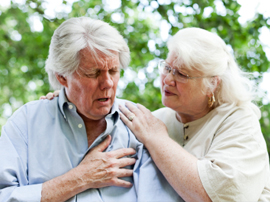“Sudden cardiac death” is about as frightening as it sounds. It strikes without warning and is often fatal, killing as many as 300,000 Americans every year, according to the American Heart Association.
Experts note that SCD — also known as Sudden Cardiac Arrest — can strike anyone, not just athletes or those with pre-existing cardiovascular conditions. But there are there are some things you can do ahead of time to determine to keep SCD from happening to you, notes top cardiologist and Newsmax Health contributor Chauncey Crandall, M.D.
“Sadly, there is no way of telling [if you’re at risk],” Dr. Crandall tells Newsmax Health. “This is a sudden event that often happens in people that don’t realize that they have underlying heart disease, so you need to follow up with your physician and make sure that you’re not at risk. But the risk factors that we see often would be hypertension, out of control diabetes, smoking, elevated cholesterol, obesity, inactivity. All of these are risk factors for [SCD].”
Dr. Crandall explains that SCD typically occurs when blockages in blood vessels — often caused by a blood clot inside one of the arteries of the heart — stop the flow of blood. That can cause death from cardiac arrest, usually within an hour of symptoms. Congenital heart defects and arrhythmias, tied to abnormal electrical charges in the heart, have also been tied to SCD, particularly among younger people and athletes. Warning signs can include chest pains, dizziness, and severe shortness of breath.
Some studies have suggested getting an ultrasound test of the heart can flag underlying conditions that might raise the risks of SCD. Experts also note that portable defibrillators — becoming increasingly common in public buildings, workplaces, and athletic centers —can be easily used to keep SCD victims alive, if and when the condition does strike.
Story continues below video.
But Dr. Crandall recommends taking a more proactive approach to reduce the risks of SCD, by losing weight, improving your diet, and lowering stress — all of which can harm the heart.
“The biggest thing is to get back to your ideal body weight, that is probably the biggest thing that we can do to help us,” he says. “The second would be to eat more of a plant-based diet. You can add fish; you can add poultry to that diet. And then third is to make sure that you’re getting follow up with your family doctor so he can evaluate possible risk signals that are there that can alert him to intervene and treat you.”
Dr. Crandall notes many people have hidden underlying conditions that put them at risk. An annual physical exam is critical to identifying such problems and treating them before they come life-threatening, particularly at middle age and older.
“Once you hit age 40 it’s … very important to continue your yearly physical exam so the physician can identify risk factors: Underlying hypertension that maybe you don’t’ know about or underlying diabetes that you’re not aware of, treating maybe hereditary cholesterol disorders that you’re unaware of,” he explains. “All these things can be evaluated at the physical exam and the great news is that we can intervene and save people’s lives.”
Dr. Crandall also believes that, in addition to exercising and eating right, more people need to take steps to lower stress levels, which put pressure on the heart.
“You know we’re in a chaotic society full of stress,” he notes. “Stress to me is probably one of the leading risk factors for heart disease so simply walking an hour every day will reduce stress, going to bed on time, getting proper sleep, being in a job of low stress … changing your lifestyle and changing the demands that are put on you will lower your stress.”
Read Latest Breaking News from Newsmax.com http://www.newsmaxhealth.com/Health-News/Sudden-Cardiac-Death-Don-t-Be-a-Victim/2013/03/21/id/495688#ixzz2OZ9SjXmX

